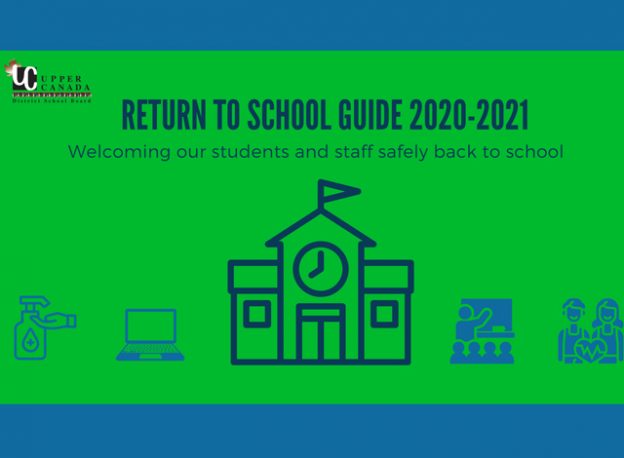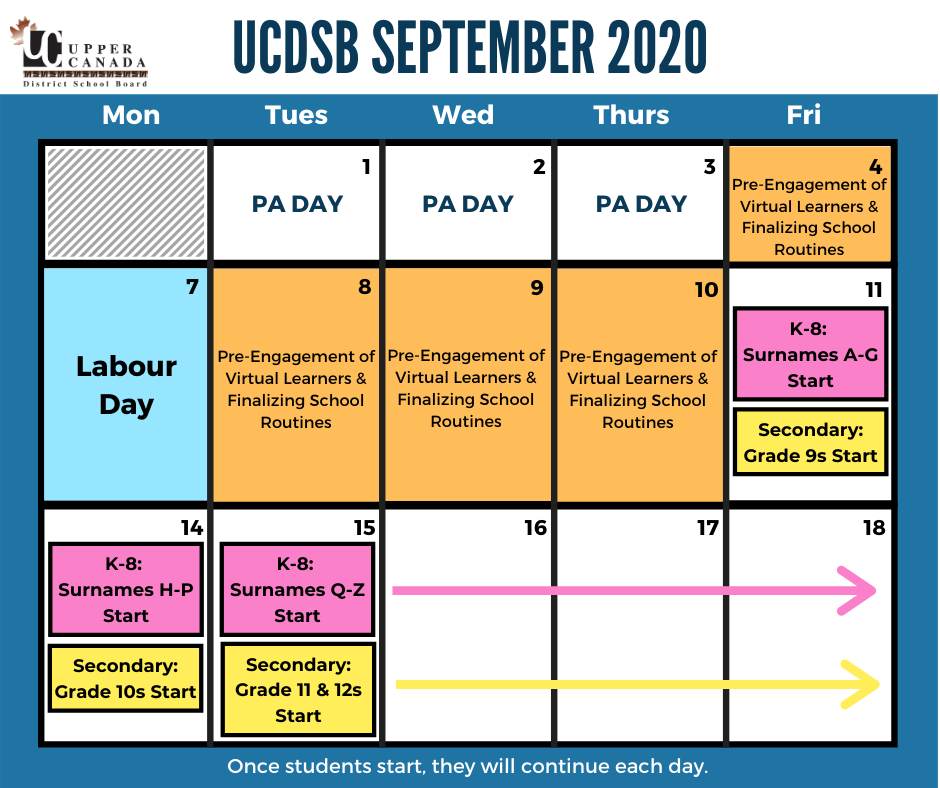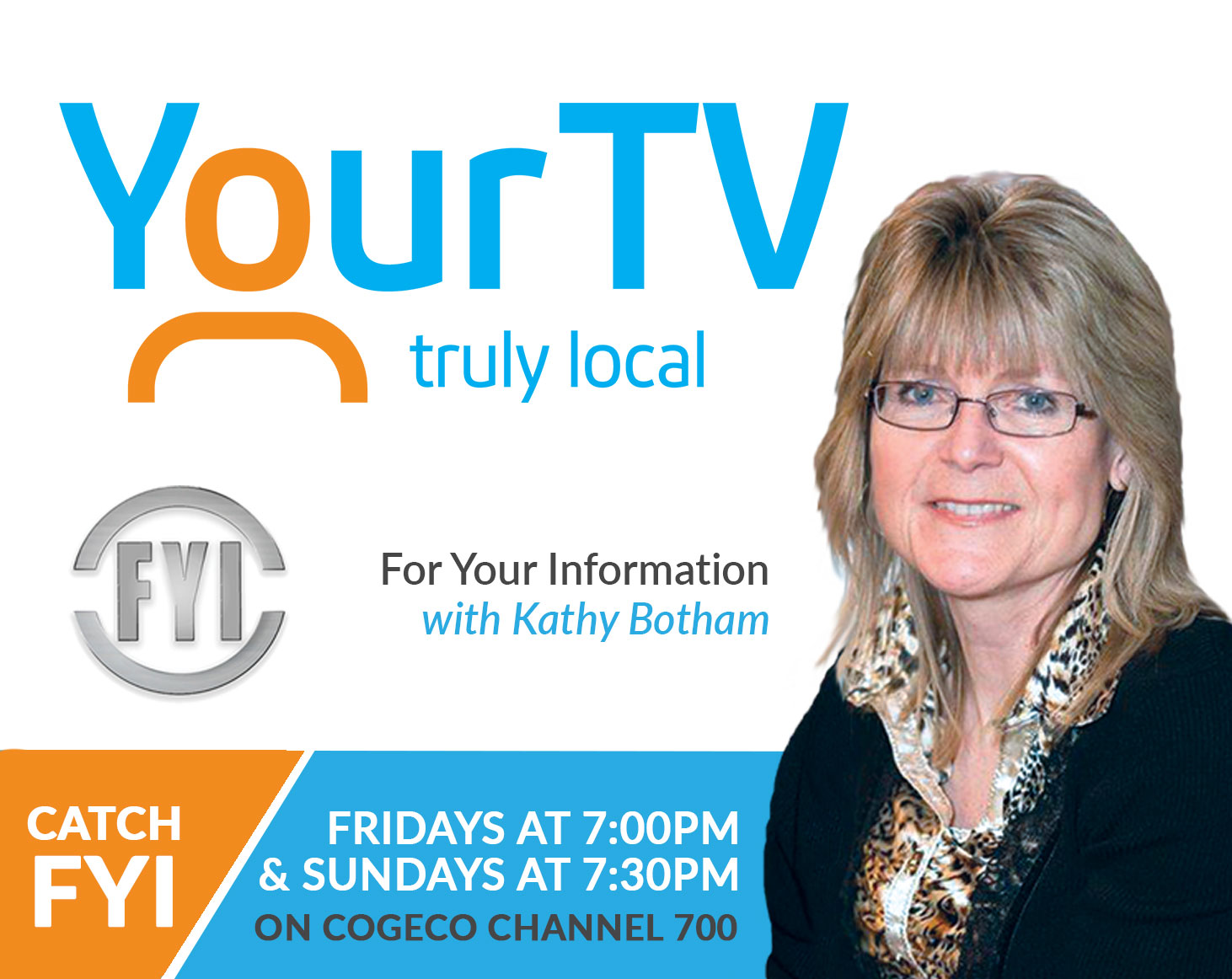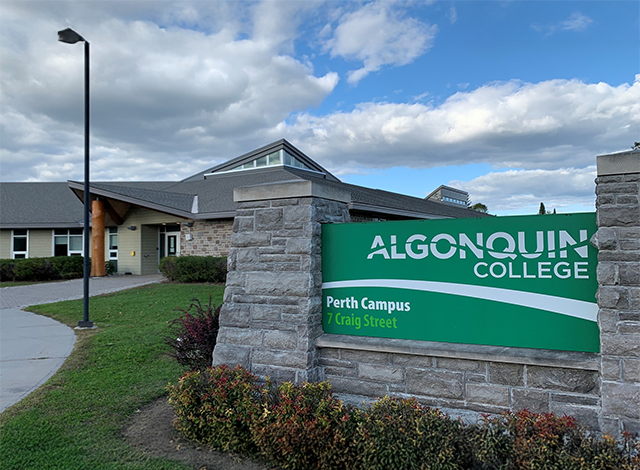The Upper Canada District School Board is looking forward to welcoming students and staff safely back to school in September.
The school district, in close collaboration with the Ministry of Education and with our local Medical Officers of Health, will be reopening schools in September using a staggered start beginning on September 11, having all students in class by September 15.
Here is how the staggered entry will work:
- For Kindergarten to Grade 8: Students with surnames A-G will start on September 11 and continue, surnames H-P will start on September 14 and continue, surnames Q-Z will start on September 15 and continue. This will have all our students in class by September 15.
- For Grade 9-12:Students in Grade 9 will start on September 11 and continue, students in Grade 10 will start on September 14 and continue, students in Grade 11 and Grade 12 will start on September 15 and continue. This will have all our secondary students in class by September 15.
We ask that you review the information in the Return to School Guide (available in the sections below or in the printable PDF) and the information in our FAQ section so that you have a better understanding of what school will look like this year and routines/practices that will be put in place.
Here is an overview of the return to school for UCDSB students:
- Elementary schools will be open full days for in-person learning, five days a week, with enhanced safety measures.
- Secondary schools will be open for in-person learning, five days a week, with enhanced safety measures.
- Students in Grades 9-12 will follow a quadmester model. Students will have two courses for the first nine weeks of the year then take an additional two courses in the next nine weeks, completing four courses by the end of January.
- Remote learning is available for all students. Students will be able to choose from remote synchronous (digital learning, in real-time, from home), remote synchronous (Digital learning, not in real time, from home) and remote asynchronous (Learning is completely offline, at home, using print materials). More information on Remote Learning can be found in Section 5.
UCDSB Return to School Guide:
Section 1: Background and Guiding Principles
Section 2: Equity and Inclusion
Section 3: Preparing Our Schools
In this section, you will find information on:
- 3.1 School Attendance
- 3.2 Admission for Students to Transfer from Distance Learning to Local Schools After September 2020
- 3.3 Preparing our School Sites – General Site Preparation Measures:
- 3.4 Water fountains
- 3.5 Custodial support in schools
- 3.6 Physical spaces within classrooms
- 3.7 Health Screening
- 3.8 Outbreak Protocol
- 3.9 Contact Tracing – Students
- 3.10 Parents, Volunteers and Visitors Within Our Schools
- 3.11 Meetings
- 3.12 Wellness Room
- 3.13 Transportation
Section 4: The Learning Environment
In this section, you will find information on:
- 4.1 Elementary Class Organization
- 4.2 Secondary Class Organization
- 4.3 Arrival and Dismissal
- 4.4 Health and Safety practices – Hand Hygiene
- 4.5 Health and Safety practices – Wearing of Masks or Face Coverings
- 4.6 Personal belongings and Storage
- 4.7 Learning materials
- 4.8 Recess
- 4.9 Lunch
- 4.10 Washrooms
- 4.11 Classroom doors
- 4.12 Use of outdoor space
- 4.13 Communication to Parents/Guardians
- 4.14 Learning Commons
Section 5: Teaching and Learning
In this section, you will find information on:
- 5.1 Mental health and well-being
- 5.2 Transition to a new grade
- 5.3 Distance Learning for the 2020-2021 School Year
- 5.4 Assessment and Evaluation
- 5.5 Secondary School Students Assessment and Evaluation
- 5.6 Provincial EQAO Assessments
- 5.7 Music
- 5.8 Physical Education, Science, The Arts, and Technology-Based Courses
- 5.9 Sports (Intramurals and Interscholastic Athletics)
Section 6: Secondary School Program Consideration: Student Success Focus
In this section, you will find information on:
- 6.1 Specialist High Skills Major (SHSM) Programs
- 6.2 OYAP and Dual Credit programs
- 6.3 Co-operative Education
- 6.4 Community Involvement / Community Service Hours
- 6.5 Literacy Requirement for Graduation
Section 7: Special Education
In this section, you will find information on:
- 7.1 Supporting Students with Special Education Needs
- 7.2 Supporting Students with Mental Health Needs
- 7.3 Transition to school
Section 8: Transition to Kindergarten
Section 9: International Education
Section 10: Preparing Staff
In this section, you will find information on:
- 10.1 Health and Safety: A Shared Responsibility
- 10.2 Staff meetings, staff rooms, and gatherings
- 10.3 Shared resources and materials
Section 11: School Operations
In this section, you will find information on:
- 11.1 Fire and Lockdown Drills
- 11.2 Field trips
- 11.3 Community use of schools
- 11.4 Assemblies
- 11.5 Electronic payments
- 11.6 Play Structures
- 11.7 Student Nutrition Programs
Background Info:Direction to School Boards for Draft Reopening Plans
On June 19, 2020 the Ministry of Education released guidelines for schools to use to create a reopening plan for the 2020-2021 school year. These guidelines identified a series of directions to protect the health and safety of students and staff related to the reopening of schools such as:
- outlining the modification of school routines;
- health and safety protocols;
- student transportation guidelines, and;
- the expectation for the availability of remote learning should some parents choose not to send their child back to school in adapted scenarios.
Among the more noteworthy aspects of the ministry guidelines was how school districts must be prepared to respond to three scenarios for the delivery of learning, which is dependent upon prevailing public health conditions. The scenarios are a follows:
- Scenario 1: a regular school day routine with enhanced public health protocols;
- Scenario 2: an “adapted” or modified school day routine based on smaller class sizes, cohorting and alternative day or week delivery, and;
- Scenario 3: Distance Learning / at-home learning with ongoing enhanced remote
It is the preference of the Upper Canada District School Board to prepare for a full return of all students to regular classes five days per week, should it be deemed safe to do so the local Chief Medical Officers of Health.
General Overview of Each Scenario
Scenario 1: Regular school day routine with enhanced public health protocols
This scenario has all students back to school, five days a week and includes increased health and hygiene measures, such as: wellness centres in schools where students and staff can isolate should they fall ill during the school day and cannot leave right away; an emphasis on hand hygiene through signage, teaching proper hand hygiene and hand hygiene stations; measure to limit close and casual contact for staff and students within the classroom and school; and frequent cleaning of high touch surfaces.
Scenario 2A: Adapted Elementary School Day / partial return to school
The Adapted Model is defined by staggering cohorts of students attending school at different times each week. In this case, the model would involve three days at school for one week, followed by two days at school the next week. Students will be able to connect with educators for distance learning whenever they cannot attend school in-person.
2B: Adapted Secondary School Day / partial return to school:
Secondary students would continue to engage in a full course load (4 courses). Instruction would be delivered both in-person and online. In this adapted model, students will attend 105 minutes of face-to-face instruction in each course in a four-day cycle by attending alternate days between the hours of 8:00 AM – 12:00 Noon. This half-day model will allow classroom teachers to engage in daily synchronous online support each afternoon.
It is understood that the adapted model is not a preferred model for working families and it can lead to confusion that comes with children not having the routine of regular school. The Ministry of Education is, however, requiring all school boards to build out this scenario given the continuing uncertainties about the community public health situation (which could change at any time, thereby changing the capacity at which schools can operate).
Scenario 3: Distance learning / At-home learning with ongoing enhanced remote delivery:
Our survey of students and parents in May 2020 and June 2020 provided us with an understanding about how the UCDSB School Reopening Plan should enhance and extend our current distance education delivery model. As a result, the following actions are underway:
- Our Board supported platforms include Microsoft Office (including email, TEAMS) and D2L-Brightspace will be the exclusive platforms used by staff as the foundation for communication and digital learning (including synchronous learning commitments) with students;
- To support the staff who need to transition from the platforms and tools that were using during 2019-2020, and recognizing the subsequent need to prepare and practice for providing distance learning experiences, a range of training opportunities and self-study resources have been made available for all UCDSB staff at the end of June 2020, with subsequent training opportunities being made available through our “Summer Institute” staff development sessions model in August 2020;
- The creation of a “Distance Learning” support team is part of our TR Leger School, in collaboration with the UCDSB’s Teaching and Learning Department. Our district’s TR Leger program has been the broker for e-learning and distance learning commitments for UCDSB students over the past 6 years and will be enhancing their work with an expanded mandate for training and support of all staff with responsibilities for distance learning;
- We have purchased an additional 1100 mobile PC devices for student use during the 2019-2020 operational year, and are planning on enhancing this increase with an additional procurement of 1100 in the 2020-2021 operational year;
- Exploring solutions to provide UCDSB families without internet services to be part of a pilot project through the “Kajeet” hotspot solutions, thereby allowing families to access the Bell 4G/LTE cellular network, and;
- An ongoing effort in 2020-2021 to improve the network infrastructure in schools to meet the rapidly evolving operational and pedagogical needs for better, faster connectivity.















